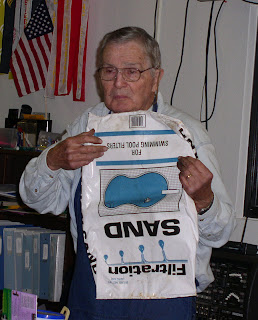Saikei is the Japanese art of creating landscapes that combine miniature living trees with soil, rocks, water, and related vegetation, like ground cover, in a single tray. In China, the art of miniature landscapes is known as penjing. Because Hal Mahoney had difficulty locating trees for use in a Saikei planting, he developed a technique by which he reduces a much larger bush, a boxwood, for example, into tree specimens suitable for use in a Saikei. Hal most often uses boxwoods from a nursery or big box store like Loew’s or Home Depot. He looks for a boxwood with multiple trunks and with as wide a base as possible. He also looks for a variation in the diameter of the “tree trunks.”
Hal begins by isolating the branches of the boxwood with a piece of cardboard. Each branch will become a separate trunk.
The second trunk is isolated. He trims each one to look like a tree and trims any branches growing inward.
The third trunk is isolated. Hal doesn’t decide on the apex or height of the individual trunk until he is farther along in the process.
The fourth trunk is isolated and trimmed.
The fifth trunk is isolated. Hal likes to do this kind of Saikei in early spring (March) when he is up North, or his second choice is to do them in September or October. Over the winter, he may bury it outside.
Hal continues to trim the individual branches to look tree-like. He uses hydrogen peroxide and wood glue to seal cuts on the trees.
Hal works on eight trunks in all, and they are all carved out of the one boxwood.
Hal has finished work on the tree clump that will eventually be the closest to the front of the tray.
He saws off the 3 clumps of trees. The closest clump is the tallest and has the highest hummock. The second clump is shorter than the first; it is at a mid-distance and has a smaller hummock than the 1st clump. The 3rd clump is the shortest, the farthest away and has the shortest hummock. Hal places the tree clumps in this way in order to create the illusion of distance. He proceeds to tie them down to the copper wire loops on the tray he has prepared. He uses only copper wire. If you heat it to red hot, then let it cool, it will become soft when coiled, then harden to be very strong. He uses an aluminum gutter nail as a chopstick.
The Chinese stopped shipping white marble trays to this country because there was a lot of breakage, so they are now very expensive. He recommends finding a marble-top table at a thrift store to use as a tray. It’s even better to use if it doesn’t have a lip. In order to have something to tie the clumps of trees down to, he uses 2 loops of wire glued to the tray. He has already decided where the clumps of trees will go in order to place the loops correctly.
The first clump is the closest to the front of the tray. It is the tallest and has the highest hummock. If it were in a real forest, it would appear to be the biggest because it is nearest to the viewer.
The first clump goes into place.
The second clump is in the mid-range to the viewer, is on a smaller hummock and is placed on what will be the opposite side of the stream.
The third clump is the farthest away from the front of the tray and farthest away from the viewer, so it is the smallest clump and on the smallest hummock.
The three clumps are now in place and tied down.
Hal gives away his “secret” soil mix. He uses filtration sand bought at a pool supplies store and peat moss 50/50. Our jaws dropped when we heard this revelation. Hal brought a picture of his bonsai trees, which are magnificent. I’m betting we will all try this soil mix, and it probably works for other plants as well. He may vary the ratio for cactus and use 75/50, sand to peat if he needs better-draining soil.
Hal fills in around the clumps with soil.
Hal keeps the stream bed clear of soil.
Hal has determined the placement of the stones beforehand.
He places them in their predetermined places, with some to define the stream. He gets his stones from Manasota Beach near Venice and Englewood, FL.
He fills in with moss.
Hal dampens the moss with a spray bottle. He doesn’t let it dry out. You can order moss on the internet or make your own with a buttermilk concoction.
The tallest clump has 8 trunks; the middle clump has 14 trunks; the smallest clump has 9 trunks--31 trunks in all. The placement of the trees is staggered so that there is a 3-D effect. The stream can look 12 inches or 12 feet--if it curves around out of sight, it appears to be longer than if it is in a straight line.
The Saikei with a white background
Hal and the completed Saikei
About Hal
Hal Mahoney has been practicing the art of bonsai for more than 35 years. Besides classical bonsai, Hal specializes in Saikei and Chinese Rock Penjing. Hal promotes bonsai through lectures and workshops throughout the United States and has been active in numerous bonsai organizations on the local, regional and international levels. During his teaching career, Hal introduced bonsai into a New York State high school science curriculum as a credit-earning course. Hal currently resides in Long Island, New York, and spends part of the year in Florida. On January 21, 2012, our club, the Bonsai Society of Southwest Florida, was privileged to host Hal for a presentation on making a Saikei planting.

























No comments:
Post a Comment